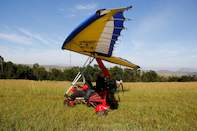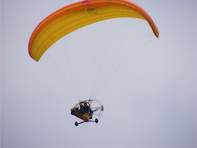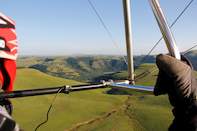Microlighting is a relatively new activity on the South African adventure menu and is an option that will appeal to both thrill-seekers and the mellow masses. Jacques Marais went airborne with his camera.

The first time I took to the skies in a microlight was while covering an adventure race in Maputaland, a wilderness area situated within the far northern reaches of Kwazulu-Natal. It was a windless day when one of the local farmers offered to grant me a bird's eye view of the event, packing me into his crop-spraying microlight to soar high above an impenetrable swathe of bush veldt bristling with fever trees and wait-a-bit thorns.
After the initial rush of take-off, I settled back to enjoy gliding along on powerful thermals, while below us competitors were locked into a bundu-bashing battle with inhospitable terrain.
Occasionally Wesley would swoop into a steep dive to chase our ground shadow, skimming a few metres above herds of impala and a few ungainly giraffe scattering across the lilliputian landscape below.
I revelled in this unique flying experience - the wind in my hair, the late afternoon sun on my face and near-consummate freedom to follow in the wingbeats of birds up on high.
Unlike a helicopter or the majority of fixed-wing flying machines, a microlight enables you to genuinely become one with the full flying experience. We did have one short moment of panic though, ducking and diving to avoid a flock of surprised vultures invading our air space, but on the whole, the flight felt as safe as driving along the N1.
None of my subsequent flips gave me any reason to think of microlighting as anything but a laid back and leisurely trip into Blue Sky country; that is, until I hooked up with Trygve Skorge.
I approached his company in order to arrange a photography flip along the West Coast and was certainly not anticipating a mind-blowing morning of aerial acrobatics. In between busy schedules and shitty weather, it had taken us nearly two months to eventually settle on a suitable date (and only after numerous 04h30 phone calls to check on fickle wind conditions out on the West Coast).
No Backing Out Now

So when D-day eventually arrives with less than a week to go to before the delivery deadline for the said article, I find myself eyeing the morning breeze with a certain amount of anxiety. But a lowly photojournalist doth hold no sway over the weather gods and I have but little choice to set off on my dawn trek to meet Trygve at a small airstrip a few kilometres inland from Melkbos.
I catch up with him where he is attending to the final pre-flight preparations, cutting a dapper figure in a leather fly-boy outfit while preparing his Aquila Trike for take-off. After the required dose of caffeine, I don an authentic Luftwaffe flying suit (another long story) before heading out to the microlight for the final safety briefing.
Trouble is, since our pre-dawn phone call the breeze has picked up considerably and snappy little crosswinds are gusting in from the Atlantic at dangerously high speeds. This obviously does not make for perfect flying conditions and I notice Trygve staring intently at the windsock, probably attempting to gauge what the wind might be up to during the next hour.
After fifteen minutes of fervent deliberation, we decide to get airborne and play it by ear - after all, it has taken us ages to get this far and God only knows if it will ever be a windless day in Melkbos anyway. We convince ourselves that we will immediately return to the airstrip should the wind speed rise into the danger zone, but I can not stop myself from stealing a timid glance at the windsock which by now is merrily snapping away further along the runway.
Trygve conducts a final safety briefing before I clamber into my seat, slightly above and behind his, listening to the motor cough a few times before snarling its way into redline territory. Goggles go on and we do a quick radio comms check as we lumber to the top end of the narrow tarmac runway, facing into the stiff breeze.
And then it is all systems go as we gun into a 200 metre sprint, with the diminutive craft kicking away from gravity's grip to spiral up and away like a giant bumblebee. Below us the earth tilts at a crazy angle and I happily start snapping away while the microlight battles into the headwind in the direction of the steely Atlantic ocean.
So far, so good - above me, the wing vibrates as we fight our way towards the coast, while behind me the diminutive motor hums along gamely. My attention drifts, drawn by the shimmer of sunlight upon the waters of Table Bay, when suddenly the world slams through 360 degrees and we spin into a juddering, downwards spiral.
I whimper an apoplectic (and fortunately silent) prayer to various deities before realising that I am not about to meet my maker and that it is merely Trygve putting his flying machine through its paces. Nonetheless I feel my grip on the camera tighten considerably as we commence climbing to an altitude of approximately 600 metres before turning west to follow the shoreline towards the hulking silhouette of Table Mountain. To our right, Robben Island languishes in all its splendour while below us, kite surfers carve frothy scars upon the freezing Big Bay waters, their colourful quad kites charging above them like giant, billowing butterflies.
Trygve decides that we are in line for a further adrenaline installment and nudges the microlight into a steep dive, apparently aiming for the frothy waterline where land and ocean meet. Down and down we plunge until we're skimming across the deserted beach a few metres above the sand, chasing our skittish shadow where it cavorts upon the breaking waves.
Adrenaline Rush

The rush is awesome as we bank across the bay to execute a low-level, downwind run, nudging the microlight's ground speed to in excess of 300km/hour before climbing towards the clouds and heading inland. On the way back to the airstrip, we have time for a quick detour over the West Coast ostrich ranch before setting course for the landing zone.
Trygve doesn't say as much, but I can sense that this will be a touch and go landing, with dangerously gusting crosswinds making conditions rather unpredictable. Phrases like "terminal velocity" and "fatal impact" tumble through my mind as we descend along the final approach, but as a passenger al I can do is sit back and wait for the inevitable.
As we approach the safety of the runway, it literally feels as if the small craft is about to shudder to pieces, but despite this everything seems to go according to plan. We're probably two metres from touchdown when a skulking crosswind blasts into us, spinning the microlight away towards the thick brush along the edge of the runway.
"This is it", I think, deciding to at least attempt a quiet and dignified death, but Trygve somehow manages to wrench his flying machine back into line, hurling what I suspect might be an extremely rude Scandinavian curse into the wind.
And then it is all over and we trundle the microlight back into the hangar before sitting down for a chat over a well-deserved cuppa. The Luftwaffe suit goes back onto the peg on the hangar wall, but not before Trygve convinces me to one day join him on one of his long distance flying safaris into the heart of the timeless Namib desert.